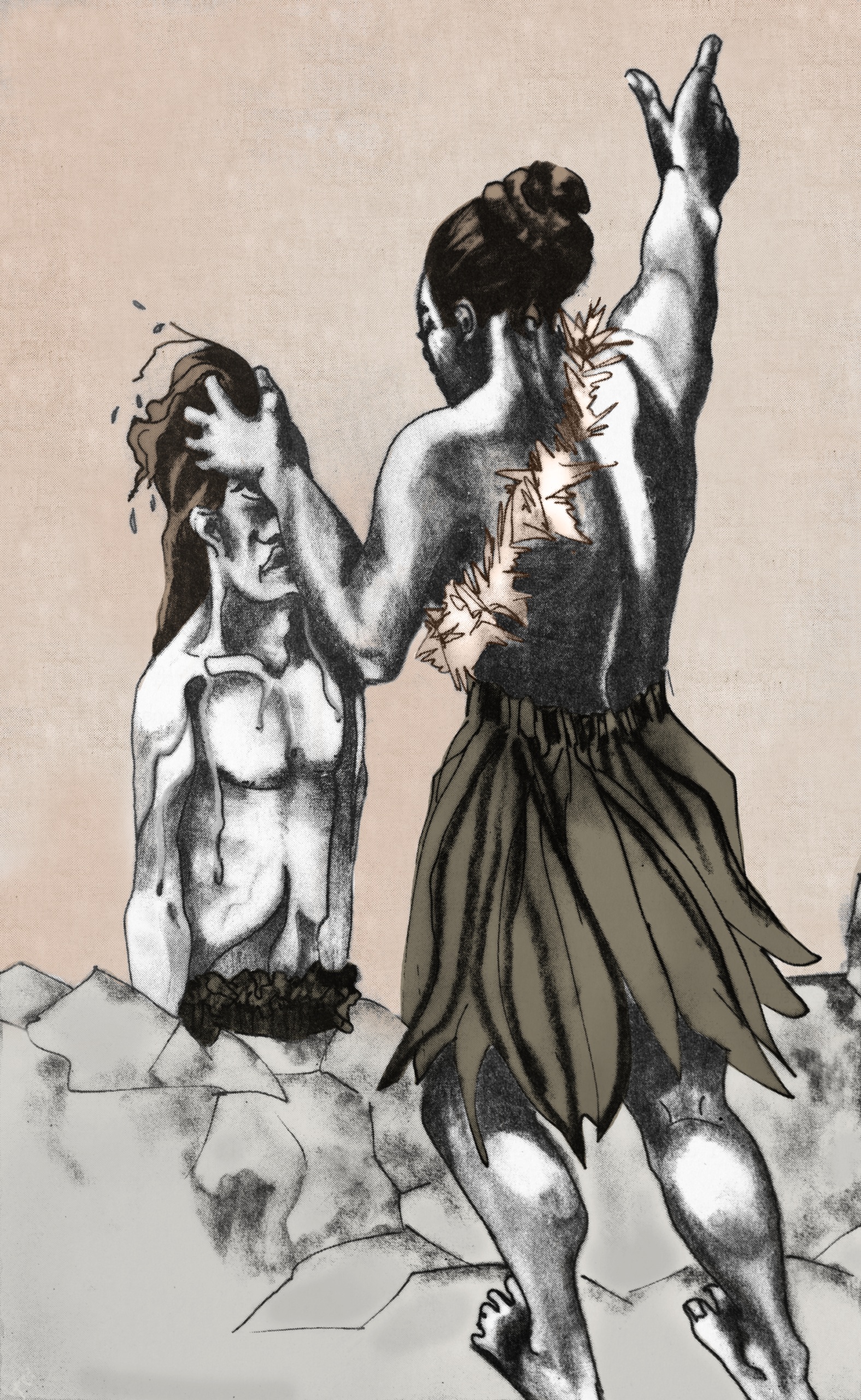
Na ia tau atu muamua ‘i le manulele lea ‘o le lupe, ‘ona ia tagi lea ma fa’apea ana ‘upu:
Le lupe e, ‘o le manu a ali’i,
Fa’amolemole lava se’i ‘ou fesili,
Pe na sau ‘i ‘inei lo’u fili?
Sā tali atu le lupe, “‘Āuōuō, ‘ua alualu lea pua’a, faimai fua ‘i ā te a’u.”Sā faiatu loa Sina, “‘la, ‘ona ‘o lou agaleaga, ”o le’ ā ‘ou ‘avatu ai le ma’a-lalago e tu’u i lou isu.” ‘E fa’apea le talitonuga, ‘o le māfua’aga lea ‘ua patupatu ai le isu o le lupe. Na tu’ua e Sina le lupe, ‘a e fa’aauau pea lana savaliga. Na ia tau atu ‘i le manuali’i, ona ia toe tagi fo’i lea ma fa’apea ana ‘upu, Le manuali’i e, ‘o le manu a ali’i,Fa’amolemole lava se’i ‘ou fesili, Pe le’i sau i ‘inei lo’u fili? Sā tali ane le manuali’i, “Sina e, sau ia, ‘o lou fili lenā o lo ‘o alu atu,”Sā faiatu loa Sina, “Ona ‘o lou agalelei, ‘avatu fulufulu ia o lo’u ‘ie e tu’u i lou isu.”
Sa tu’ua loa e Sina le manuali’i ‘a e fa’atele’a’i atu e tuliloa lona fili. Na ia tau atu ‘i le manuma, ‘ona ia fesili lea ‘i le manumā pe le’i va’ai ane ‘i lona fili. Sā tali ane le manumā, ‘o lenā lava o lo ‘o alu atu lou fili. Sā tū Sina ma faiatu ‘i le manumā, “Fa’afetai i lou agalelei, ‘a e ‘avatu la’u ‘ie-sina lea e tu’u i lou fatafata.”
Na ia tu’ua le manumā, ‘a e toe savali e tuliloa lona fili. Na ia tau atu ‘i le manutagi, ‘ona ia tagi lea ma fa’apea ana ‘upu.
‘O le manutagi, ‘o le manu a ali’i,
Fa’ amolemole lava se’i ‘ou fesili,
Pe le’i ui mai ‘i ‘inei lo’u fili?
Sā tali ane le manutagi, “Talefa e i ā Sina, ‘o lou fili lena o lo ‘o alu atu. Toeitiiti lava ‘e maua mai.”
Sā faiatu loa Sina ‘i le manutagi, “Taluai ona ‘o lou agalelei, ‘avatv lo’u ‘ie-‘ula lea e f a1 alanurnūmu ai lou isu, ‘a e ‘avatu lo’u ‘ie pu’upu’u leā e fusi ai lou fatafata.”
Na tu’ua e Sina le manutagi ma toe savali loa e tuli lona fili.
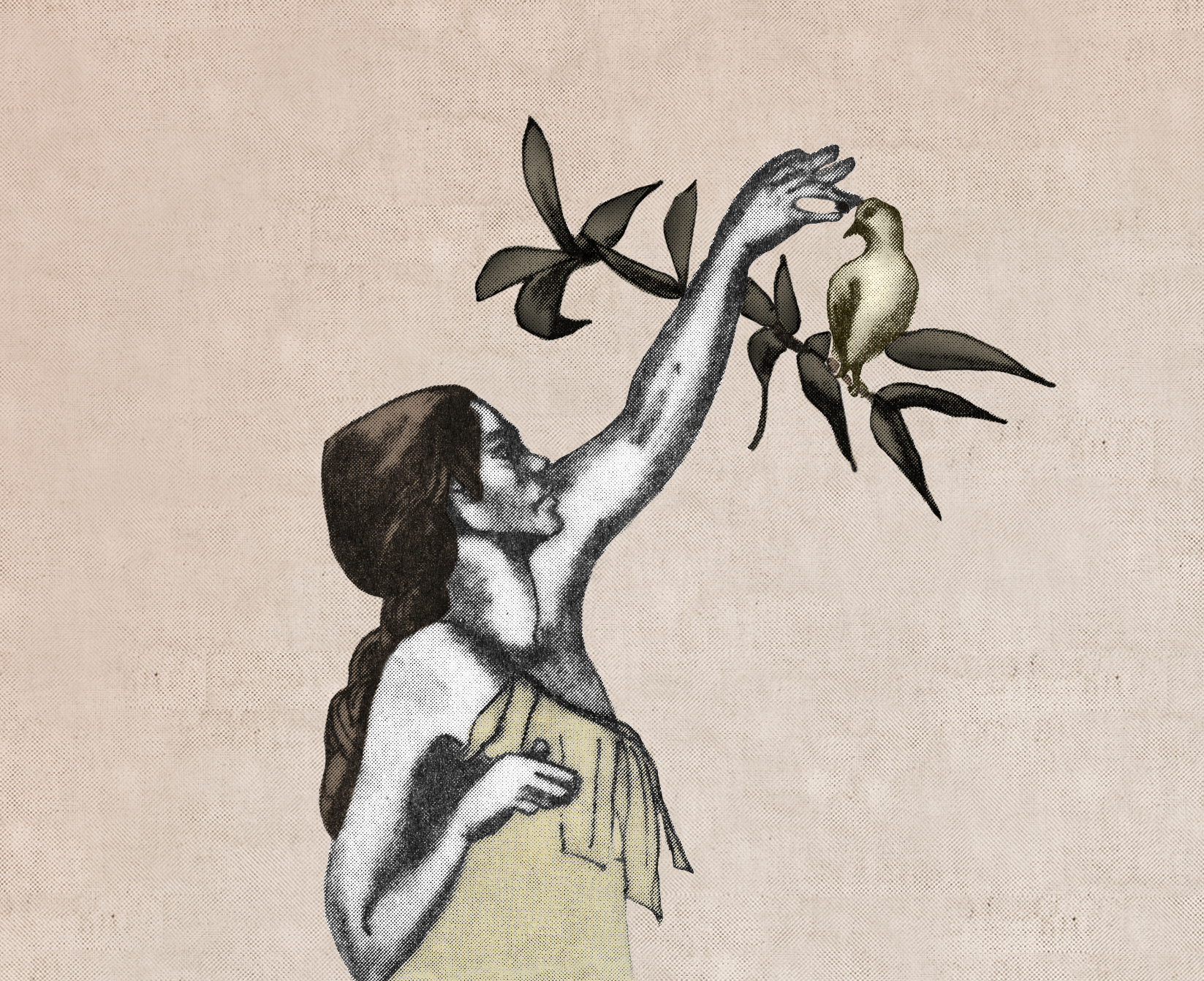
‘O le sega, ‘o le manu a ali’i,
Fa’amolemole lava se’i ‘ou fesili,
Pe le’i sau ‘i ‘inei lo’u fili?Sa tali ane loa le sega, “Funa Sina, sau ‘ ina savali. ‘A ‘e tau atu ‘i le tama’ita’i ‘o Matamōlali, ‘ona ‘e tago lea i se si’ usi’ u-launiu ma sasa ai mata o lenā tama’ ita’ i.”Sā faiatu loa Sina, “Fa’afetai sega i lou agalelei, ‘a e ‘avatu a’u mea ia e teu ai lou tino. ‘Avatu le toe vāega lea o lo’u ’ie-‘ula e fusi ai lou fatafata. ‘A e ‘avatu la’u lei lea e tu’u i lou gutu, ma lo’u falavulu-‘ula
fua o niu ma fua o la’au suamalie ‘uma o le vao.”
Na tu’ua e Sina le sega ma savali loa e su’e le tama’ita’i ‘o Matamolali.
Na ia fafa’i ifo fo’i le si’usi’u—launiu mai le launiu o le nitumuli na ia tau atu ‘i ai i le ala. Na ia ‘ave lea si’usi’ u-launiu ma savali loa. Na ia maua atu Matamolali i le ala, ma sā ia le toe fa’atali loa, ‘a ‘ua sasa loa mata o Matamolali i le si’usi’u-launiu. Sā fa’ataiō le tama’ita’i ‘o Matamolali, ma fa’apea ana ‘upu, “Po ‘o ai lenei vale o Samoa ‘ua na sasa o’u mata?”
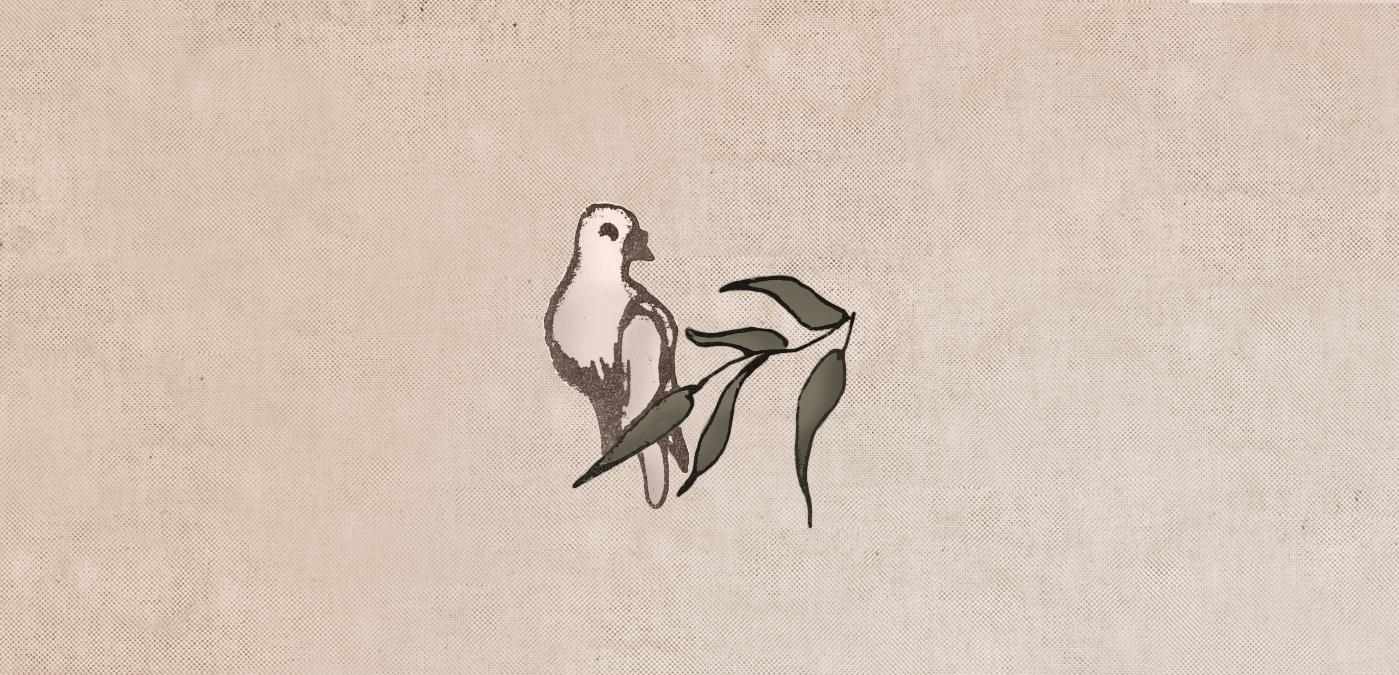
Sā toe fesili atu le tama’ita’i ‘o Matamolali, “Po ‘o le ā lou fili?”
Sā tali Sina, “‘O la’u tāne ‘ua oti.”
Sa faiatu loa Matamolali, ” ‘Ua lelei, ‘a e sau loa ts 5 ‘5 te fa’atali atu i le fale, ‘a ‘o le’ā ‘ou alu ‘ou te sa’ilia.”
Sā alu ane loa Sina ‘ua fa’atali atu i le fale, ‘a ‘ua alu Matamolali
e sā’ili mai le tāne a Sina. Sa alu loa Matamolali ‘i le mea o lo ‘o iai le vaiola ma le vaiali. Na ia tau ‘ i ia vai, ‘ ona ia susu’ e lea o le vaiola, ‘a e pupuni le vaiali. ‘0 vai ia e tā’e’ele ane ‘i ai tagata ‘ua feoti. Sā nofonofo ai loa le tama’ita’i ‘o Matamolali ma fa’atali ai le ta-imi e gāsolo atu ai. ‘E le’i leva tele talu ‘ona nofonofo le tama’ita’i ‘ i ‘ ina, ‘ a e sau loa ma le solo a taupou ma manaia. Sa filo mai ai fo1 i ma le tamāloa e to’ atasi. Na gāsolo ane ali’ i ma taupou se’ ia o’ o ‘ ina ‘ua latalata ane le tamaloa, ‘ona faiatu loa lea o Matamolali, “Se’i ‘aumai lau ‘ula mā a’u.” Sa sōsō ane loa le tamaloa ‘i a Matamolali, ‘a e sa tago atu le tama’ita’i ‘ua toso mai ma fasi loa. Sa ia toe tulei le tamāloa ‘i le vaiola ma lelemo ai. Sa tagi le tamaloa ma fa’apea a’e,
“Ta fia ola! ta fia olaJ”

Sa fesili atu loa le tama’ita’i, “‘O fea ‘ō?”
“‘Ō sisifo.” ‘0 ā le tamāloa lea.
“’O fea ‘5?”
“‘O sasa’e.”
“‘O fea ‘ō?”
“‘O utā.”
“‘O fea ‘ō?”
‘0 tai.”
‘”0 fea ‘ō?”
“‘O luga.”
“‘O fea ‘i?”
‘0 lalo.”
Sa faiatu loa Matamōlali ‘i le tamāloa, “‘la sau lā’ia tā 5, ‘ua ‘e atamai.”
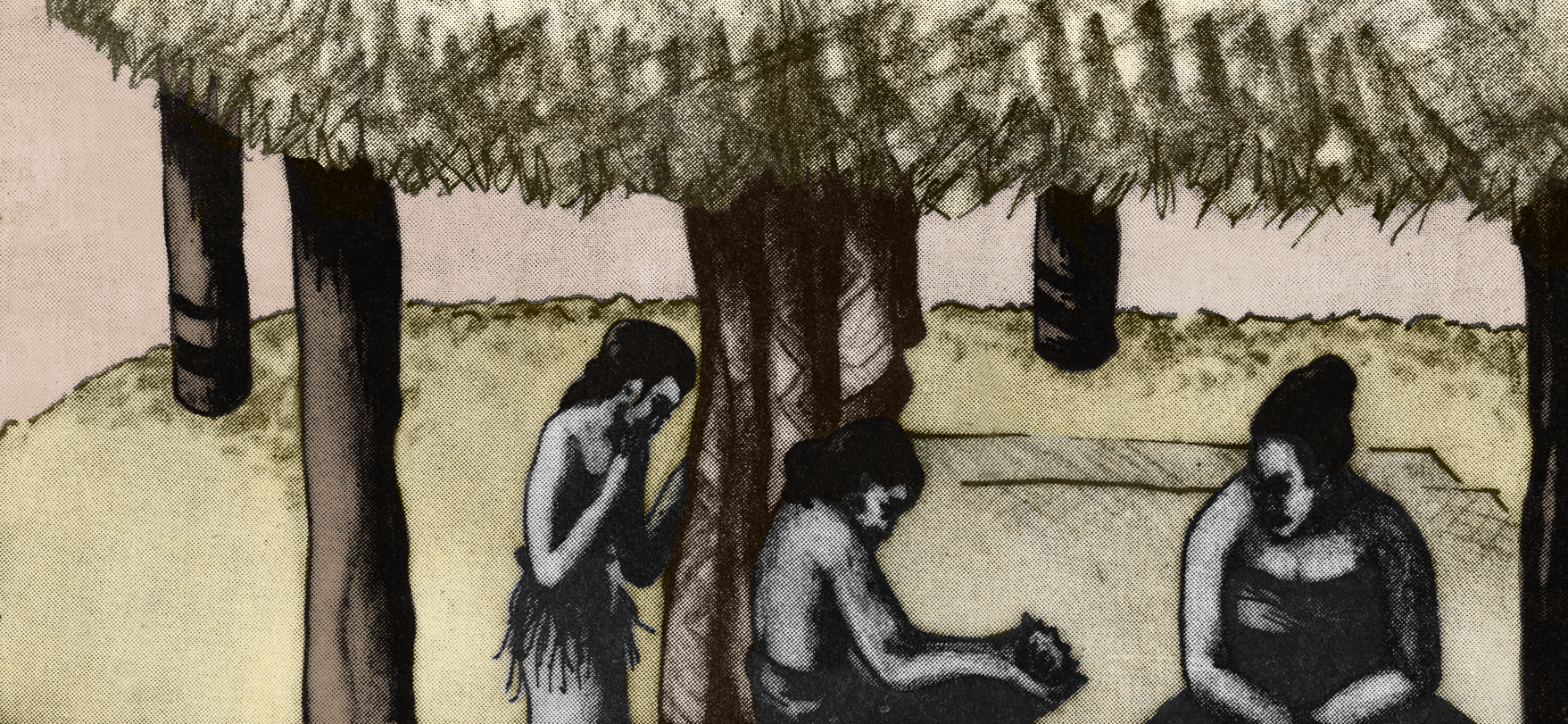
ona fa’apea lea o Matamolali, “Funa e, se’i ‘aumai se ‘ie e lavalava ai le ali’i, leaga ‘ua susū Iona ‘ie.”
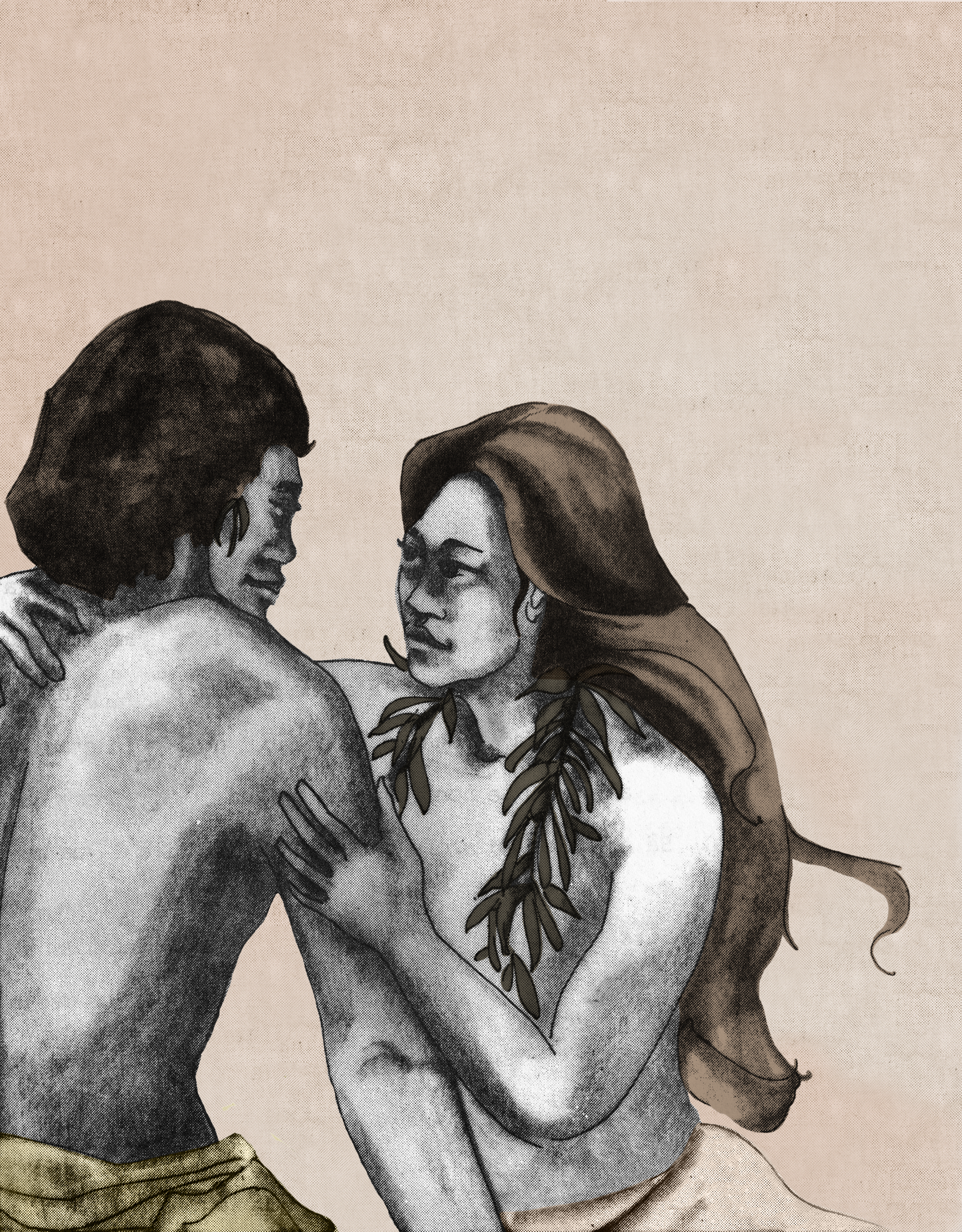
Sa tali atu le ali’i, “‘Ou te misialofa ‘i le ‘ie, ‘ona e pei ‘uma lava ‘o le mā ‘ie ma Sina.”
Sā faiatu Matamōlali, “Ali’i, fa’apea na ‘o ‘oulua ma Sina e maua ni ‘ie fa’apenāl”
Sā toe vala’au Matamōlali ‘i ā Sina, “Funa, se’i ‘avane se selu e selu ai le ulu o le ali’i.”
Sā tago if o f o’ i Sina ‘ i le lā selu ma togi ane ‘ i ai. Na tepa ifo le ali’i ‘i le selu, ‘ona toe misialofa fo’i lea o le ali’i. Sa toe fesili ane fo’i Matamōlali, “Po ’o le ā le mea ‘e te misialofa ai?”
Sa tali ane le ali’i, “‘Ou te misialofa ‘i le selu, ‘ona e pei ‘uma
lava ‘o leinā selu ma Sina.”Sa faiatu Matamōlali, “Ali’i, pe na ‘o ‘oulua ‘ea ma Sina e maua selu fa’apenā?”
Na ‘uma ‘ona selu le ulu o le ali’i, ‘ona nofo ifo lea ‘i lalo ma le
fa’anoanoa tele o Iona loto, ‘ina ‘ua fa’amanatu ane e le selu ma le ‘ie le la mafutaga fa’aulugāli’i ma si ana mānamea ‘o Sina. Ma ‘ua ātili ai ‘ona oso ane Iona alofa ma Iona fia va’ai ‘i ā Sina.
Na iloa e Matamōlali fōliga fa’anoanoa o le ali’i, ‘ona fa’apea lea o ana ‘upu ‘i ā Sina , “Sina e, fa’aali mai ia ‘i si ali’i nei, ‘a lailoa e alofa.”
Na cso ane loa Sina mai tua o le pupuni, ’a ‘ua tūla’i atu fo’i le ali’i ‘o Tulau’ena ma fa’afetaia’i le oso mai a Sina. Sa la fusifusi loa ma feāsogi ma fetagisi. Sa la ncnofo ifo ‘i lalo ma talatalanoa fiafia ai. ‘A ‘o le tama’ita’i ‘o Matamōlali ‘ua tū ane ia ‘i luga ma alu atu ‘ua sāuni mai le lātou nea’ai. Sa lātou ‘a’ai ma fiafia fa’atasi ai.
Sā maua fo’i ma le lātou fa’ai’uga, o le’ā lātou nonofo fa’atasi ai pea i le fale o fiatamōlali. ’O le nonōfoga lea a Sina ma Tulau’ena na fanafanau ai Sina. Sā agalelei ma alofa fo’i Matamōlali ‘i ā lā’ua ma si fāhau.

Sina determined that her beloved husband Tulau’ena died, just as he predicted, when she saw his blood in the waves breaking on the shore. She resolved to find his body so she could provide a proper ceremonial burial. She went first to their house, to gather things she would need to prepare for her journey in search of his remains. Sina had a great knowledge of birds and their powers, so she put on her back her special feathered cloth, gathered her special rocks, and began her long walk through the forest to search for her husband’s remains. She knew he would no longer be in the ocean, but instead, on the path to Pulotu where all departed souls go, and was confident the birds would help and guide her. She also knew he would be accompanied by an ali’i (spirit) who might be in the form of a bird, who might know where he was being taken by her enemy ali’i.
She first came across a bird called the pigeon. Appealing to the pigeon, she cried out with these words:
Le lupe e, o le manu a ali’i (Pigeon, the bird of the chiefs)
Fa’amolemole lava se’i ‘ou fesili, (Please, may I ask)
Pe na sau ‘i ‘inei lo’u fili? (Did my enemy come here?)
The pigeon responded in a manner most uncharacteristically rude for pigeons, saying, as if to no one in particular, “Oh, oh, oh! All of a sudden this lady, like a pig, is talking to me.”
Bitterly hurt and offended, but knowing her powers, Sina then replied, “Fine! for your unkindness I will put a rock on your nose.” And she did. This explains why there is a bump on the nose of the pigeon.
Sina left the pigeon and continued her walking to find her murdered husband’s remains. She came across a manuali’i (purple swamp hen) so she cried out again:

Le manuali’i, o le manu a ali’i, (The manuali’i, the manu of the chief’s)
Fa’amolemole lava, se’i ‘ou fesili, (Please, may I ask)
Pe na sau ‘i ‘inei lo’u fili? (Did my enemy come here?)
The manuali’i immediately grasped the situation and answered in warning, “Sina, come here, your enemy is coming.”
Sina then told the manuali’i with gratitude, “Because of your kindness, take these beautiful feathers from my cloth and put them on your nose.”
So Sina left the manuali’i and sped ahead to search for her enemy. She came across a manuma (many-colored fruit dove) so she asked the manuma if it had seen her enemy. The manuma answered, “Your enemy is still coming.” Sina stopped and said to the manuma, “Thank you for your kindness, take my white cloth here and put it on your chest.”
She left the manuma and continued her walk to catch up with her enemy. She came across a manutagi (crimson-colored fruit dove) so she cried out these words:

Le manuali’i, o le manu a ali’i, (The manuali’i, the manu of the chief’s)
Fa’amolemole lava, se’i ‘ou fesili, (Please, may I ask)
Pe na sau ‘i ‘inei lo’u fili? (Did my enemy come here?)
The manutagi answered, “Poor Sina, your enemy was just here. You almost came in time.”
Sina then told the manutagi, “Because of your kindness, take my red cloth to make your nose red and take my short cloth here to tie around your chest.”
Sina left the manutagi enriched and made more beautiful by her gift, and continued walking through the forest to apprehend her enemy.
When she came across the sega (the blue-crowned lory bird), so she cried out these words:

Le manuali’i, o le manu a ali’i, (The manuali’i, the manu of the chief’s)
Fa’amolemole lava, se’i ‘ou fesili, (Please, may I ask)
Pe na sau ‘i ‘inei lo’u fili? (Did my enemy come here?)
The sega answered with a curious recommendation: “Sina, come and listen. Keep walking on your path. When you come across a woman named Matamolali- and you will- grab the heavy branches of the coconut tree which have fallen nearby and strike the Matamolali across the eyes with them. Only then will Matamolali help you!”
Sina then thanked the sega, “Because of your kindness, take these things to beautify your body. This is all I have left. Take the rest of the parts of my red cloth and tie it around your chest. And take this lei (ivory) and put it in your mouth and my feathered necklace to use as a feather on your back. And you will eat the fruits of the coconut and all the sweet blossoms of the forest.”
Sina left the sega and walked on looking for the lady Matamolali. She also broke off a coconut branch that she found along the way. Armed with the coconut branch, she kept on walking.
Soon, she met up with Matamolali along the road and, without waiting, she began furiously to hit her face with the coconut branch. The lady Matamolali began to cry out and said, “Who is this fool of Samoa? Why is she hitting my face with a coconut branch?”
Sina then answered, “It is I who came to you to ask where my enemy was.”
The lady Matamolali asked again, “Who is your enemy?”
Sina answered, “My enemy is the spirit who is wrongfully guiding my husband who was unjustly murdered to the next world.”
Matamolali understood, and answered in reassurance, “Alright, let’s go. You will wait at the house while I go to search.”
Sina then went to the house and waited while Matamolali went to look for Sina’s husband. Matamolali went to where the vaiola (water of life) and the vaiali was. She reached those waters then opened the vaiola and blocked the vaiali. These waters are where people who died would go to bathe while waiting to enter. Matamolali sat there and waited for the time the dead would begin filing in. She did not wait long before Sina’s husband appeared.
Matamoli knew how to bring a soul back from the journey to Pulotu, and immediately went to work. The souls filed in according to their rank and status. After the prince and princesses entered, only one man followed, the last in line with the rest of the dead. Matamoli suspected he was Sina’s husband. She asked him, “How about you give your necklace to me?” Believing he had misunderstood the words of Matamoli, he moved closer to her, whereupon she grabbed him and set upon him with her fists, and pushed him into the vaiola where he realized he would be drowned. The man cried out in protest, begging, “I want to live, I want to live!”
Matamolali heard what she wanted to hear – that Tulau’ena wanted to live- and then said, “It’s good you want to live. Perhaps you will. But try and answer correctly the name of these locations I will point my finger to.”
The lady then asked the following, “Where is that?”
“It’s west.”
“Where is that?”
“It’s the east.”
“Where is that?”
“It’s inland.”
“Where is that?”
“It’s seaward.”
“Where is that?”
“It’s upward.”
“Where is that?”
“It’s downward.”
Matamolali then said to the man, “Alright, you may go back to the path of life, since, because you appear very smart, I will let you go.”
Matamolali and Tulau’ena started to walk home. As they walked, Sina observed that her husband was coming with Matamolali, and being afraid, she ran inside the house and hid behind the blinds. Matamolali and her husband reached the house.

Matamolali said to Sina who remained hidden from her husband’s sight, “Miss Sina,” she said, “bring a ‘ie (a mat to wear) for the man to use. He nearly drowned and his clothing is wet.” In fact, Tulau’ena had been saved from drowning in the pool where the dead pass through by the intervention of Matamolali, and might have been in transition to ali’i status into the spirit world of the departed. But, with the ministrations of Matamolali he was still capable of returning to life.
Sina grabbed their ‘ie and threw it to him. Tulau’ena looked at the ‘ie and expressed a sad, sympathetic feeling. Matamolali asked Tulau’ena, “Why are you trying to evoke our sympathy?”
Tulau’ena answered, “I’m showing sadness for the ‘ie because it looks just like the ‘ie that belonged to me and and my wife Sina.”
Matamolali said to him, “Sir, do you think you and Sina are the only ones that can get an ‘ie like that?”
Matamolali again called out to Sina, “Miss Sina, give the ali’i (referring to Tulau’ena) a comb to comb his hair.
Again, Sina gave him their comb by tossing it to him. The ali’i looked at the comb, then again expressed a sad, forlorn feeling. Matamolali asked him, “Why are you being sympathetic again?”
Tulau’ena answered, “I’m showing sadness about the comb because it looks just like the comb that belonged to me and Sina.”
Matamolali said to him, “Sir, do you think you and Sina are the only ones that have a comb like that?”

After the ali’i of Tulau’ena had combed his hair, he sat down with his heart full of sorrow because the comb and the ‘ie had reminded him of his love for his dear wife Sina. He yearned even more because of his desire to see Sina again.
Matamolali saw the sadness in his face and she said to Sina, “Sina, go ahead and show yourself to this ali’i.”
Sina jumped from behind the blinds and at the same time, Tulau’ena also jumped to greet Sina. They then hugged and kissed and cried. They sat down and talked with happiness. Matamolali stood up and walked over to prepare them some food. They all ate together and were completely happy. Together, they all decided that they would continue to live together at Matamolali’s house. It is at this place that Sina and Tulau’ena lived and where Sina gave birth to children. Matamolali was also kind and loved them and their children, and never left their lives for as long as they were together.
<!–
Comments are closed here.